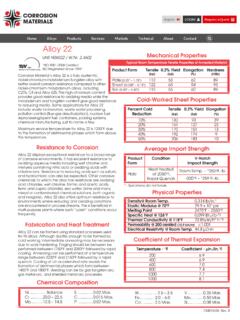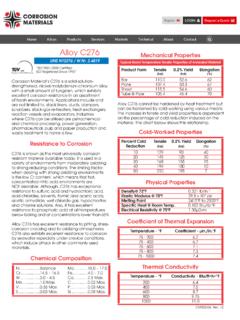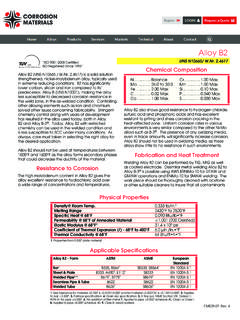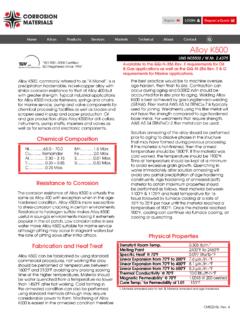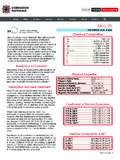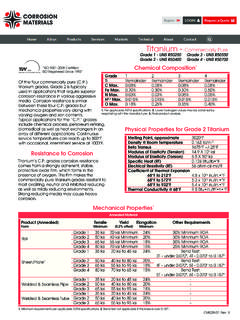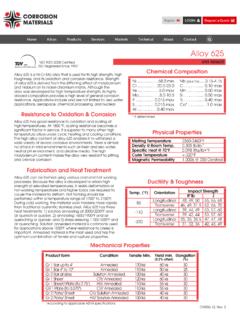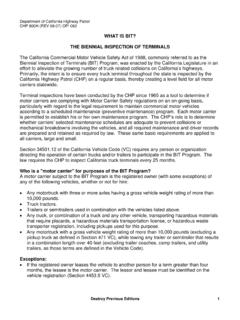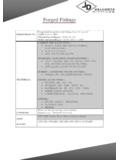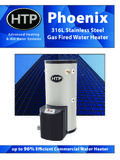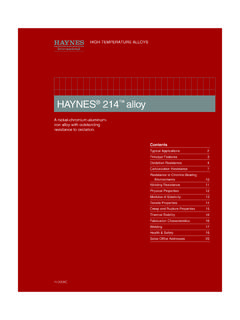Transcription of Alloy 800H/HT - Corrosion Materials
1 Alloy 800H/HT UNS N08810 & N08811/ & ISO 9001-2008 CertifiedISO Registered Since 1993 Mechanical PropertiesProduct Form Condition Tensile (ksi) Yield (ksi) Elongation (%)Rod & Bar Annealed 75 to 100 30 to 60 60 to 30 Density@ Room Temp. Point 2475 F to 2525 FSpecific Heat @ 70 F Btu/lb FPermeability @ 70 F for Annealed Material (200 Oersted)Curie Temperature -175 FElastic Modulus @ 75 F (Tension) X 106 psiElastic Modulus @ 1600 F (Tension) X 106 psiElectrical Resistivity @ 70 F 595 ohm circ mil/ftElectrical Resistivity @ 1800 F 776 ohm circ mil/ftPhysical Properties1CM024-07, Rev. 3 Chemical CompositionAlloy 800h Alloy 800HT Ni .. to .. to Cr .. to .. to C .. to .. to Max.
2 Max. S .. Max.. Max. Max.. Max.. Max. P .. Max.. Max. Al .. to .. to Ti .. to .. to ..Remainder ../ ..Al + Ti = to 800h /800HT (UNS N08810 & N08811 / & ) are solid solution strengthened, iron-nickel-chromium alloys , typically offered as one, dual certified Alloy meeting the elemental requirements of both alloys . The principle difference between Alloy 800h and 800HT material is the restricted aluminum and titanium content in 800HT , which results in higher creep and stress rupture properties. Both Alloy 800h and 800HT are superior to Alloy 800 (UNS N08800), having greater creep and stress rupture properties. The Alloy is typically used for applications involving long-term exposure to high-temperatures where resistance is needed from oxidation, carburization and other types of high-temperature Corrosion .
3 Hydrocarbon processing, heat-treat furnaces and power generation are some of the most common applications where 800h & 800HT is utilized. Pressure vessels and vessel components constructed from 800h and 800HT are approved under the ASME, Boiler and Pressure Vessel Code, Section VIII, Division to CorrosionHigh nickel and chromium contents in both Alloy 800h and 800HT result in excellent resistance to oxidation, carburization and sulfidation. The high nickel content also increases the resistance to nitriding, although not as good as other alloys such as Alloy 600, which contains a higher percentage of and Heat TreatmentHot-working temperatures should be between 1600 F and 2200 F with heavy forming to be performed at temperatures above 1850 F.
4 No forming should be performed between 1200 F and 1600 F and preheating of tools and dies to 500 F is suggested to avoid chill. Cooling after hot working should be as quick as possible, avoiding extensive time at temperatures between 1000 F and 1400 F. Cold working should be performed on material in the annealed condition. Stress relief or annealing should be considered depending on the total amount of strain induced by fabrication taking into consideration the intended service of the material. Because excessive grain growth can negatively affect mechanical properties, care must be taken in selecting an annealing temperature and time at temperature for the process. If material is to be deformed more than 20% and a final anneal is desired, fine-grain material should be considered for the starting relief is performed between 1000 F and 1600 F and should be at temperature for 1 hour per inch of material or for a minimum of 1 hours at 1600 F, whichever is greater.
5 Recrystallization anneal is achieved at temperatures between 2100 F and 2200 The compositional range of Alloy 800h falls within the range of 800HT, therefore there is no significant difference in physical , Rev. 3 Alloy 800H/HT - Form ASTM ASME British EuropeanStandard StandardBar1 B408, B5641 SB408, SB5641 BS3076-NA152 EN Pipe3 B407 SB407 / EN Pipe4 B514 SB514 / EN SpecificationsThe data and information contained in this pamphlet have been taken from open literature and is believed to be reliable. The information contained is intended to be used as a guide. Corrosion Materials does not make any warranty or assume any legal liability for its accuracy, completeness or machine and weld facilities help insure that the most common items will be in stock.
6 Items not in stock can be fabricated in a short period of time either in-house or through our extensive, approved subcontractor and supplier contact Corrosion Materials for a complete list of available items from Temperature Mechanical Properties Temperature Tensile Yield Hardness( F) (ksi) (ksi) (BHN)800 /1000 901200 841400 741. Applies to pipe ". Size tolerance on this material is + " ". 2. Alloy 800h only 3. ASTM grain size 5 or courser per ASTM E112. 4. X-Ray per ASME Section VIII, Division 1, #UW-51 for pipe ". Aqueous Corrosion Data (Laboratory tests at 176 F) Media Common Name Test Duration (days) Corrosion Rate (mpy)10% C2H4O2 Acetic Acid 7 / no pitting5% Al2(SO4)3 18H2O Aluminum Sulfate 7 / no pitting5% NH4Cl Ammonium Chloride 42 / pitting after 42 days10% NH4OH Ammonium Hydroxide 7 / no pitting5% (NH4)
7 2 SO4 Ammonium Sulfate 7 nil / no pitting10% BaCl2 Barium Chloride 42 / pitting after 42 days5% CaCl2 Calcium Chloride 42 / pitting after 42 days5% H2 CrO4 Chromic Acid 7 / no pitting10% C6H8O7 Citric Acid 7 nil / no pitting10% CuSO4 Copper Sulfate 7 nil / no pitting5% FeCl3 Ferric Chloride 42 420 / pitting after 7 days10% C3H6O3 Lactic Acid 7 / no pittingCH3OH Methanol 7 Nil / no pitting10% C2H2O4 Oxalic Acid 7 / no pitting5% C6N6 FeK3 Potassium Ferricyanide 7 / no pitting5% NaHSO3 Sodium Bisulfite 7 / no pitting20% Na2CO3 Sodium Carbonate 7 nil / no pittingNaCl Sodium Chloride 42 / pitting after 7 days5% NaOCl Sodium Hypochlorite 42 / pitting after 7 days5% Na2SO4 Sodium Sulfate 7 nil / no pitting10% C4H6O6 Tataric Acid 7 / no pitting10% ZnCl2 Zinc Chloride 42 / pitting after 42 daysWe also supply a complete range of items in the following alloys ; Alloy C276, B2, B-3 , F-255, Alloy 22, 625, 200/201, Alloy 400, 405 and 600.
8 Bar products are also available in K500, Alloy 800H/HT , and Alloy 6B as well as various Ti grades.(800HT is a registered trademark of Special Metals Corporation. B-3 is a registered trademark of Haynes International Inc.}ShanghaiRoom 1202333 Jiujiang Road Shanghai, China 200001 86-21-6045 2221/2223 Fax: 86-21-6045 2225 Baker2262 Groom Box 630 Baker, Louisiana 70714(800) 535-8032(225) 775-3675 FAX: (225) 774-0514 Houston12305 Cutten , Texas 77066(800) 455-2276(713) 939-0364 FAX: (713) Emergency ServicePricing & Documents Available on Our WebsiteChicago375 W. South Frontage Rd. Bolingbrook, Illinois 60440(800) 706-7471(630) 226-1043 FAX: (630) 226-1044)
